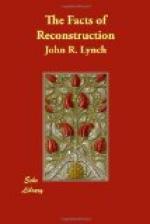The inevitable conflict between the antagonistic elements of which Southern society was composed could no longer be postponed. But the colored vote was the important factor which now had to be considered and taken into account. It was conceded that whatever element or faction could secure the favor and win the support of the colored vote would be the dominant and controlling one in the State. It is true that between 1868 and 1872, when the great majority of Southern whites maintained a policy of “masterly inactivity,” the colored voters were obliged to utilize such material among the whites as was available; but it is a well-known fact that much of the material thus utilized was from necessity and not from choice, and that whenever and wherever an acceptable and reputable white man would place himself in a position where his services could be utilized he was gladly taken up and loyally supported by the colored voters.
After 1872 the necessity for supporting undesirable material no longer existed; and colored voters had the opportunity not only of supporting Southern whites for all the important positions in the State, but also of selecting the best and most desirable among them. Whether the poor whites or the aristocrats of former days were to be placed in control of the affairs of the State was a question which the colored voters alone could settle and determine. That the colored man’s preference should be the aristocrat of the past was perfectly natural, since the relations between them had been friendly, cordial and amicable even during the days of slavery. Between the blacks and the poor whites the feeling had been just the other way; which was due not so much to race antipathy as to jealousy and envy on the part of the poor whites, growing out of the cordial and friendly relations between the aristocrats and their slaves; and because the slaves were, in a large measure, their competitors in the industrial market. When the partiality of the colored man for the former aristocrats became generally known, they—the former aristocrats,—began to come into the Republican party in large numbers. In Mississippi they were led by such men as Alcorn, in Georgia by Longstreet, in Virginia by Moseby, and also had as leaders such ex-governors as Orr, of South Carolina; Brown, of Georgia, and Parsons, of Alabama.
Between 1872 and 1875 the accessions to the Republican ranks were so large that it is safe to assert that from twenty-five to thirty per cent of the white men of the Southern States were identified with the Republican party; and those who thus acted were among the best and most substantial men of that section. Among that number in the State of Mississippi was J.L. Alcorn, J.A. Orr, J.B. Deason, R.W. Flournoy, and Orlando Davis. In addition to these there were thousands of others, many of them among the most prominent men of the State. Among the number was Judge Hiram Cassidy, who was the candidate of the Democratic party for Congress from the Sixth




